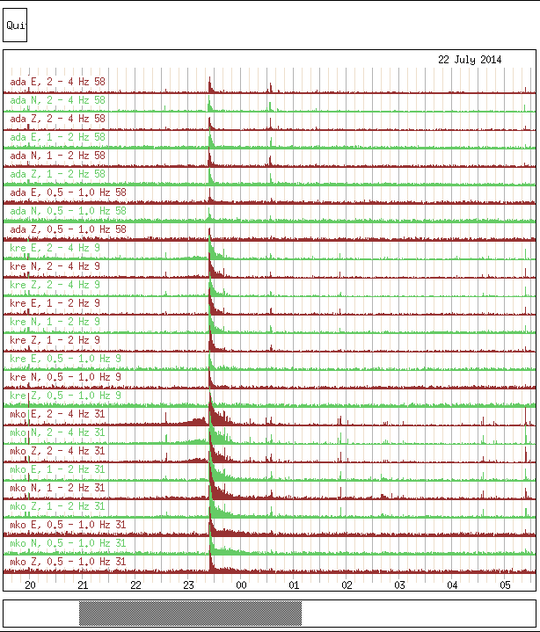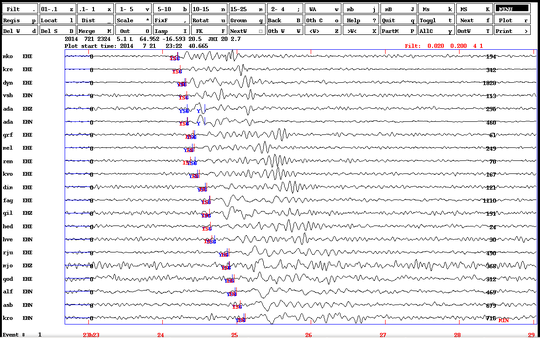Seismic signal associated with the Askja rockslide
Martin Hensch, Sigþrúður Ármannsdóttir and Kristín S. Vogfjörð
The enormous rockslide on the eastern caldera rim of Askja volcano on 21st July 2014 around 23:25 was accompanied by a strong and unusual seismic signal, seen even far away from the source region.
The signal appeared on tremor graphs on all seismometers around Askja. It started with a strong pulse that subsequently decreased over the next 20-25 minutes (see figure 1, enlarge). Similar signals are sometimes seen for strong earthquakes far away from Iceland, however no strong earthquake had been detected by international networks at the same time.
Figure 1

Detailed investigation of the signal revealed that its frequency in the initial phase was around 0.05 Hz, which is unusually low. Figure 2 (enlarge) shows seismograms filtered between 0.02 and 0.2 Hz. The onset of the first wave is marked in red. The low frequency signal is followed by higher frequencies of about 1-4 Hz, which slowly fade out over the next twenty minutes. This signal can be seen on all seismometers around Askja, while the low frequency signal can be seen on broadband seismometers throughout the whole country.
The traveltime of the signal from Mókollar (mko) close to Askja to station Ásbjarnarstaðir (asb) in Borgarfjörður is about 55 s; the distance between both stations is about 220 km. This gives the signal an apparent velocity of around 4 km/s, which is characteristic for a surface wave. As no body waves are seen prior to the low frequency onset, this event clearly differs from a normal tectonic earthquake which usually starts with clear onsets of P- and S-waves prior to the surface waves.
Figure 2

Interpretation
The preliminary interpretation of this signal is that the low frequency waves in the beginning reflect a slow rupture process in the slope of the caldera wall. The peak in tremor is subsequently caused by the debris fall into the lake. The following flood wave in the lake migrated several times back and forth, causing continuing but decreasing tremor that was seen during the next twenty minutes after the rockslide.
There is no evidence for a strong steam explosion in the earthquake data. However it can not be ruled out that temporarily strong hydrothermal activity following the rockslide might have caused the steam plume that was observed minutes after the slide (photo: Kolbeinn Helgi Gíslason).




